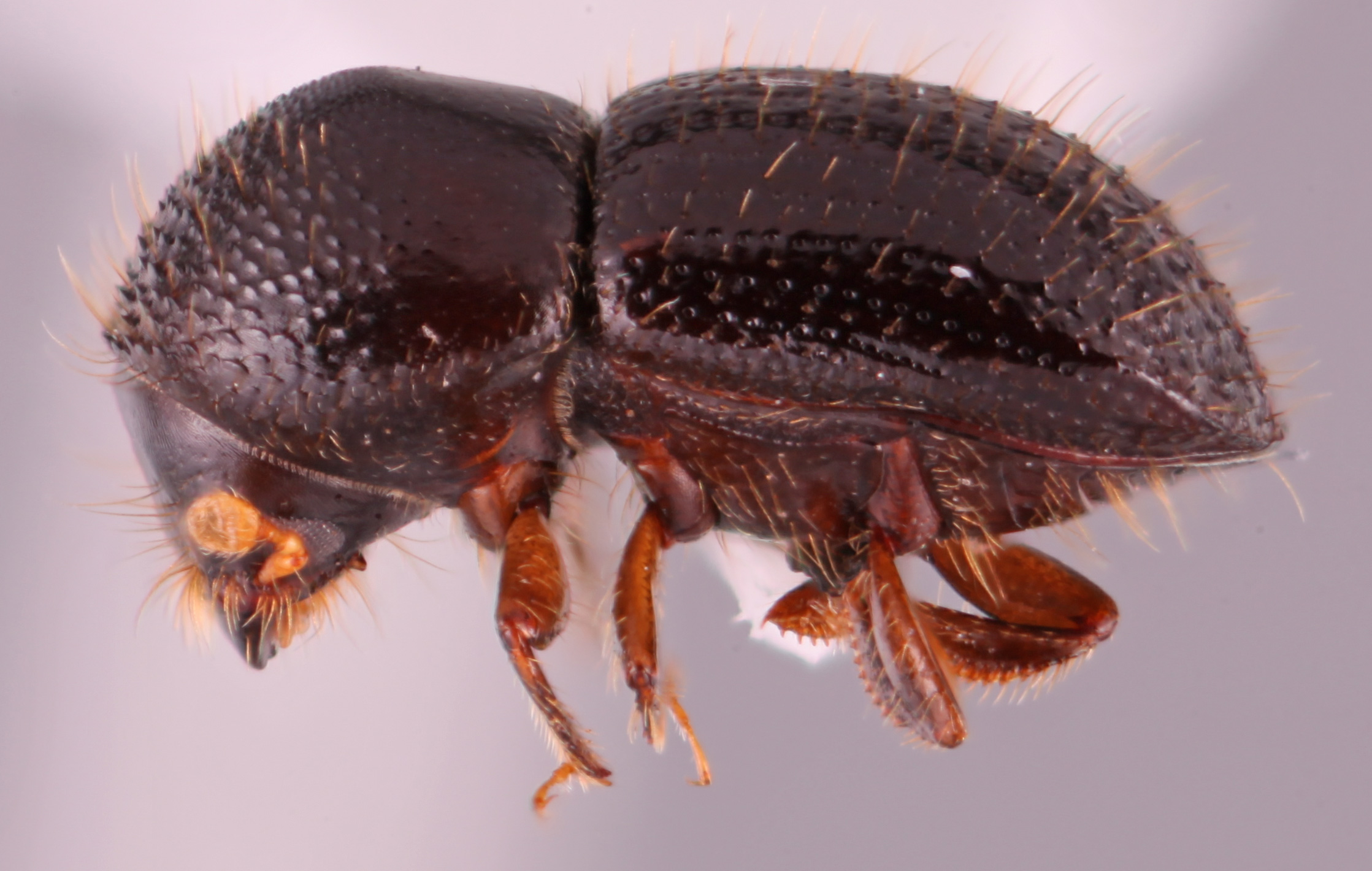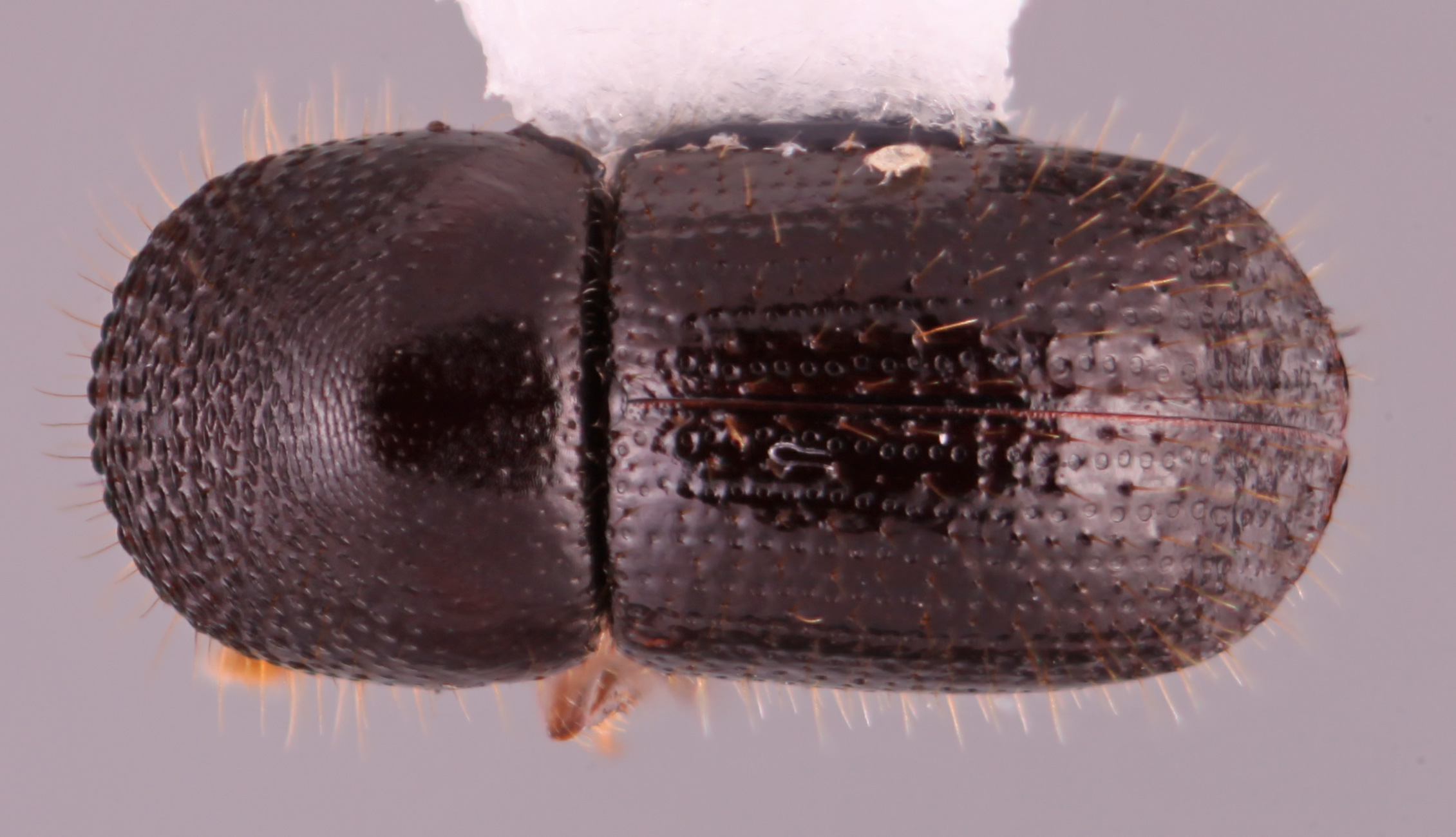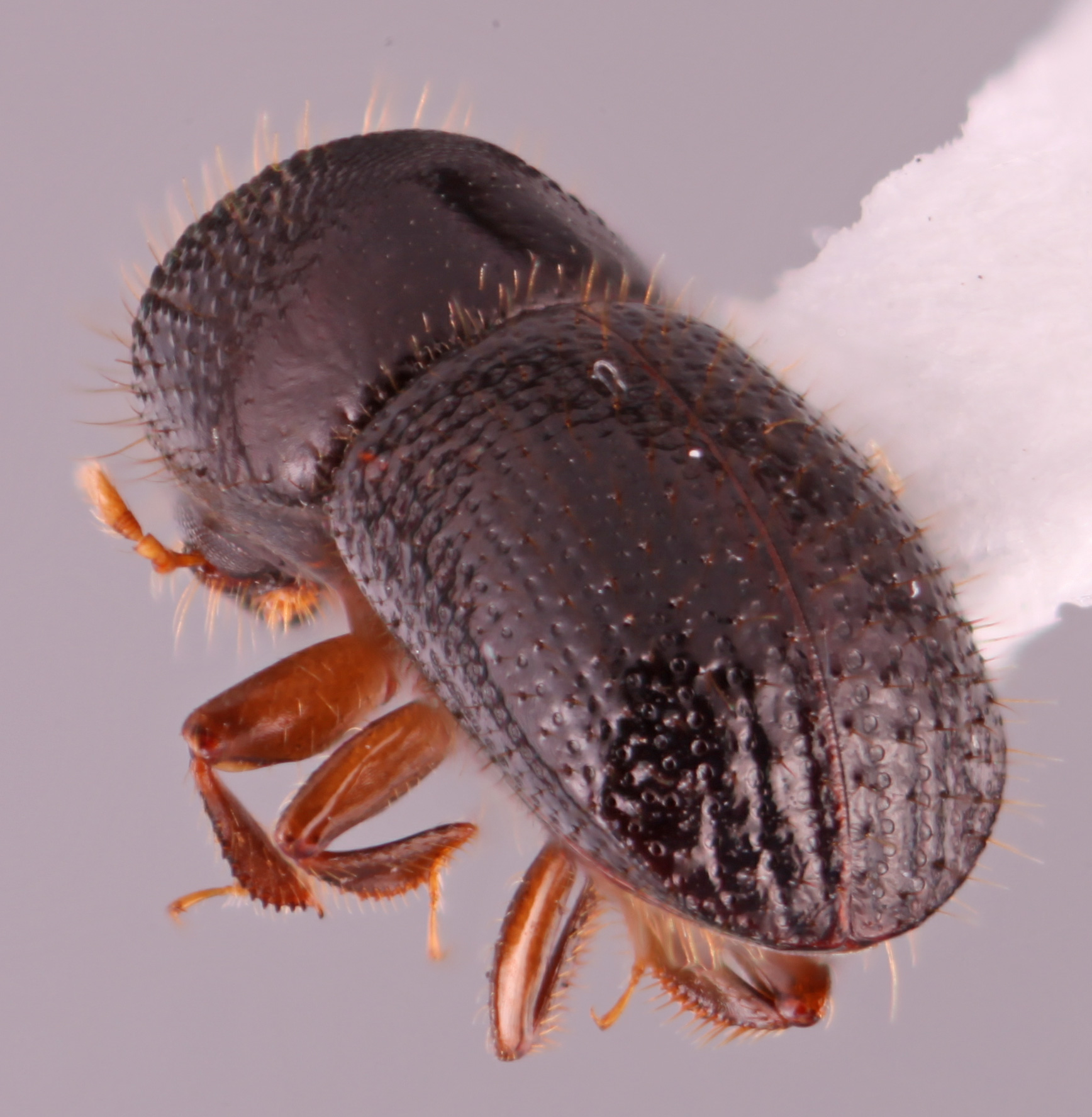Euwallacea kuroshio
|
Euwallacea kuroshio lateral; S.M. Smith |
|
Euwallacea kuroshio dorsal; S.M. Smith |
|
Euwallacea kuroshio declivity; S.M. Smith |
|
Euwallacea kuroshio frontal; S.M. Smith |
Taxonomic history
Euwallacea kurishio Gomez & Hulcr 2018 (in Gomez et al. 2018bGomez et al. 2018b:
Gomez DF, Skelton J, Steininger MS, Stouthamer R, Rugman-Jones P, Sittichaya W, Rabaglia RJ, Hulcr J. 2018b. Species within the Euwallacea fornicatus (Coleoptera: Curculionidae) complex revealed by morphometric and phylogenetic analyses. Insect Systematics and Diversity 2(6): 2, 1-11. https://doi.org/10.1093/isd/ixy018): 9.
Diagnosis
2.4–2.8 mm long (mean = 2.6 mm; n = 10); 2.17–2.4 times as long as wide. This species is distinguished by the pronotumpronotum:
the dorsal surface of the thorax
basic (type 2) when viewed dorsally, anterioranterior:
the front or forward; opposite of posterior margin appearing rounded; elytralelytral:
margin appearing rounded; elytralelytral:
pertaining to the elytra
declivitydeclivity:
downward slope of either the pronotum or elytra
 rounded; declivitaldeclivital:
rounded; declivitaldeclivital:
pertaining to the elytral declivity
face convexconvex:
appearing rounded ; protibiaprotibia:
; protibiaprotibia:
tibia of the first pair of legs
outer margin rounded with 8−11 socketed denticlesdenticle:
a small tooth, the sides of which are equal and the tip is above the middle of the base , denticlesdenticle:
, denticlesdenticle:
a small tooth, the sides of which are equal and the tip is above the middle of the base small, their sockets small; declivitaldeclivital:
small, their sockets small; declivitaldeclivital:
pertaining to the elytral declivity
surface shiningshining:
appearing glossy or bright in luster; referring to a surface that is polished and reflects light well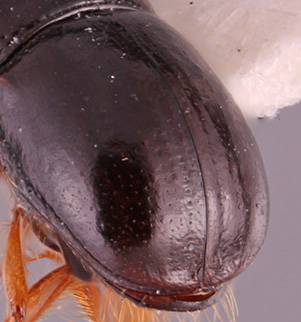 ; interstriaeinterstria:
; interstriaeinterstria:
longitudinal spaces along the elytra between the striae, which is not as<br />
impressed and bear smaller punctures.
 bearing sparse small granulesgranule:
bearing sparse small granulesgranule:
a small rounded protuberance, like grains of sand
 , posterolateralposterolateral:
, posterolateralposterolateral:
relating to end of the side part/portion
 margin of declivitydeclivity:
margin of declivitydeclivity:
downward slope of either the pronotum or elytra
 costate. This species is nearly identical to E. malloti and E. n. sp. 5 and can be separated by the elytralelytral:
costate. This species is nearly identical to E. malloti and E. n. sp. 5 and can be separated by the elytralelytral:
pertaining to the elytra
bases rounded and posterolateralposterolateral:
relating to end of the side part/portion
 declivitaldeclivital:
declivitaldeclivital:
pertaining to the elytral declivity
costacosta:
elevated ridge that is rounded at its crest, not necessarily with sharp appearance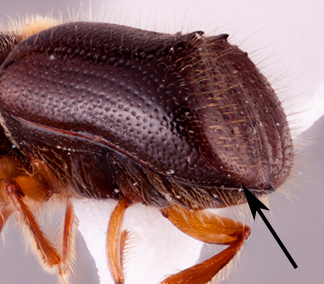 carinate and never granulategranulate:
carinate and never granulategranulate:
pertaining to a coarse, grainy surface texture
 .
.
This species is part of the Euwallacea fornicatus species complex, and the most reliable method to ensure accurate identification of these species is through generation of COI barcoding sequences (Gomez et al. 2018bGomez et al. 2018b:
Gomez DF, Skelton J, Steininger MS, Stouthamer R, Rugman-Jones P, Sittichaya W, Rabaglia RJ, Hulcr J. 2018b. Species within the Euwallacea fornicatus (Coleoptera: Curculionidae) complex revealed by morphometric and phylogenetic analyses. Insect Systematics and Diversity 2(6): 2, 1-11. https://doi.org/10.1093/isd/ixy018, Smith et al. 2019Smith et al. 2019:
Smith SM, Gomez DF, Beaver RA, Hulcr J, Cognato, AI. 2019. Reassessment of the species in the Euwallacea fornicatus (Coleoptera: Curculionidae: Scolytinae) complex after the rediscovery of the ldquo;lostrdquo; type specimen. Insects 10: 261. https://doi:10.3390/insects10090261). Gomez et al. (2018b; figure 1) provide morphological characters for separating the species based on measurements of elytralelytral:
pertaining to the elytra
length (lateral view; diagonally measured from the elytralelytral:
pertaining to the elytra
basebase:
point or edge closest to the body; opposite of apex to the apexapex:
to the apexapex:
point or edge furthest from the body; opposite of base
 ) and pronotalpronotal:
) and pronotalpronotal:
pertaining to the pronotum
length (lateral view; on a diagonal from pronotalpronotal:
pertaining to the pronotum
apexapex:
point or edge furthest from the body; opposite of base
 to pronotalpronotal:
to pronotalpronotal:
pertaining to the pronotum
basebase:
point or edge closest to the body; opposite of apex ). Species can be diagnosed using the combination of measurements given in Smith et al. 2019:
). Species can be diagnosed using the combination of measurements given in Smith et al. 2019:
| species | total length (dorsal) |
length/width ratio (dorsal) |
elytral elytral: pertaining to the elytra length (lateral; diagonal) |
pronotalpronotal: pertaining to the pronotum length (lateral; diagonal) |
elytral elytral: pertaining to the elytra width (dorsal) |
pronotal pronotal: pertaining to the pronotum width (dorsal) |
protibial denticles |
| E. fornicatior | 2.20–2.37 | 2.15−2.35 | 1.40–1.46 | 1.02–1.06 | 0.48–0.52 | 1.00–1.06 | 6−7 |
| E. fornicatus | 2.60−2.70 | 2.25−2.36 | 1.44–1.72 | 1.02–1.16 | 0.48–0.62 | 1.00–1.14 | 8–9 |
| E. kuroshio | 2.40−2.80 | 2.17−2.40 | 1.50–1.82 | 1.08–1.16 | 0.52–0.56 | 1.06–1.16 | 8−11 |
| E. perbrevis | 2.30−2.50 | 2.46−2.55 | 1.42–1.68 | 1.04–1.16 | 0.48–0.56 | 1.02–1.14 | 7−10 |
May be confused with
This species is part of the Euwallacea fornicatus species complex along with E. fornicatior, E. fornicatus and E. perbrevis from which it is difficult to distinguish. The species is also similar to Coptodryas inornata, E. andamanensis, E. geminus, E. malloti, E. neptis, E. semirudis, E. testudinatus, E. velatus, and Xylosandrus formosae.
Distribution
Indonesia (East Java), Japan (Okinawa), Taiwan. This species has been introduced into Mexico and the United States (California) (García-Avila et al. 2016, Gomez et al. 2018bGomez et al. 2018b:
Gomez DF, Skelton J, Steininger MS, Stouthamer R, Rugman-Jones P, Sittichaya W, Rabaglia RJ, Hulcr J. 2018b. Species within the Euwallacea fornicatus (Coleoptera: Curculionidae) complex revealed by morphometric and phylogenetic analyses. Insect Systematics and Diversity 2(6): 2, 1-11. https://doi.org/10.1093/isd/ixy018, Stouthamer et al. 2017Stouthamer et al. 2017:
Stouthamer R, Rugman-Jones P, Thu PQ, Eskalen A, Thibault T, Hulcr J, Wang L-J, Jordal BH, Chen C-Y, Cooperband M, Lin C-S, Kamata N, Lu S-S, Masuya H, Mendel Z, Rabaglia R, Sanguansub S, Shih H-H, Sittichaya W, Zong S. 2017. Tracing the origin of a cryptic invader: phylogeography of the Euwallacea fornicatus (Coleoptera: Curculionidae: Scolytinae) species complex. Agricultural and Forest Entomology 19: 366-375. https://doi.org/10.1111/ afe.12215, Smith et al. 2019Smith et al. 2019:
Smith SM, Gomez DF, Beaver RA, Hulcr J, Cognato, AI. 2019. Reassessment of the species in the Euwallacea fornicatus (Coleoptera: Curculionidae: Scolytinae) complex after the rediscovery of the ldquo;lostrdquo; type specimen. Insects 10: 261. https://doi:10.3390/insects10090261).
Host plants
This species is known from Sambucus (Adoxaceae), Liquidambar (Altingiaceae), Schinus, Searsia (Anacardiaceae), Ambrosia, Baccharis (Asteraceae), Alnus (Betulaceae), Ricinus (Euphorbiaceae), Quercus (Fagaceae), Cassia, Persea (Lauraceae), Ficus (Moraceae), Eucalyptus (Myrtaceae), Juglans, Pterocarya (Juglandaceae), Magnolia (Magnoliaceae), Fraxinus (Oleaceae), Platanus (Platanaceae), Populus, Salix (Salicaceae), Nicotiana (Solanaceae), Tamarix (Tamaricaceae) (Boland 2016Boland 2016:
Boland JM. 2016. The impact of an invasive ambrosia beetle on the riparian habitats of the Tijuana River Valley, California. Peer J 4: e2141. https://doi.org/:10.7717/peerj.2141, Na et al. 2018Na et al. 2018:
Na F, Carrillo JD, Mayorquin JS, Ndinga-Muniania C, Stajich JE, Stouthamer R, Huang YT, Lin YT, Chen CY, Eskalen A. 2018. Two novel fungal symbionts Fusarium kuroshium sp. nov. and Graphium kuroshium sp. nov. of Kuroshio shot-hole borer ( Euwallacea sp. nr. fornicatus ) cause Fusarium dieback on woody host species in California. Plant Disease 102: 1154-1164.
0
0
1
6
38
MSU Dept. Entomology
1
1
43
14.0
Normal
0
false
false
false
EN-US
JA
X-NONE
/* Style Definitions */
table.MsoNormalTable
{mso-style-name:"Table Normal";
mso-tstyle-rowband-size:0;
mso-tstyle-colband-size:0;
mso-style-noshow:yes;
mso-style-priority:99;
mso-style-parent:"";
mso-padding-alt:0in 5.4pt 0in 5.4pt;
mso-para-margin:0in;
mso-para-margin-bottom:.0001pt;
mso-pagination:widow-orphan;
font-size:12.0pt;
font-family:Cambria;
mso-ascii-font-family:Cambria;
mso-ascii-theme-font:minor-latin;
mso-hansi-font-family:Cambria;
mso-hansi-theme-font:minor-latin;}
https://doi.org/10.1094/PDIS-07-17-1042-RE
0
0
1
15
89
MSU Dept. Entomology
1
1
103
14.0
Normal
0
false
false
false
EN-US
JA
X-NONE
Coleman TW, Poloni AL, Chen Y, Thu PQ, Li Q, Sun J, Rabaglia RJ, Man G, Seybold SJ. 2019. Hardwood injury and mortality associated with two shot hole borers, Euwallacea spp., in the invaded region of southern California, USA, and the native region of Southeast Asia. Annals of Forest Science 76: 61. https://doi.org/10.1007/s13595-019-0847-6, Smith et al. 2019Smith et al. 2019:
Smith SM, Gomez DF, Beaver RA, Hulcr J, Cognato, AI. 2019. Reassessment of the species in the Euwallacea fornicatus (Coleoptera: Curculionidae: Scolytinae) complex after the rediscovery of the ldquo;lostrdquo; type specimen. Insects 10: 261. https://doi:10.3390/insects10090261).
Remarks
This species is commonly known as the Kuroshio shot hole borer (KSHB) and has been referred to as this in publications before the species was formally described (e.g. Stouthamer et al. 2017).
DNA data
Sequences are available from COI and CAD.
COI: MN619937
CAD: MN620212
The holotype has been sequenced for COI (KU727004). Additional COI sequences can be found in Gomez et al. (2018b) and Smith et al. (2019)

